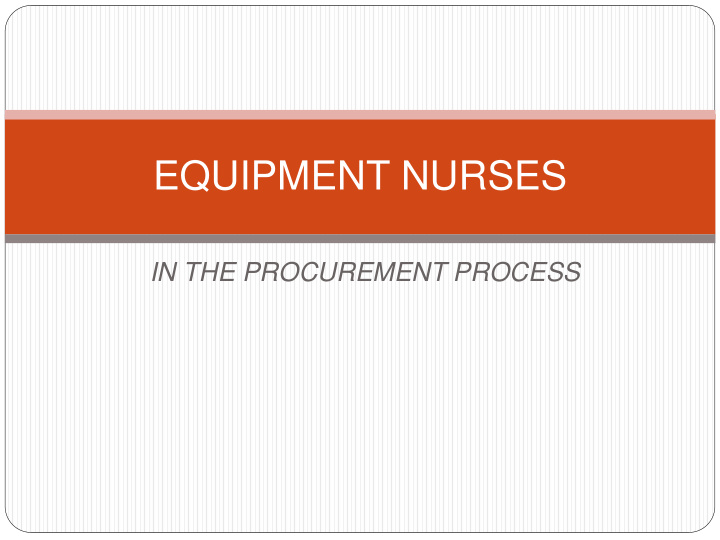



EQUIPMENT NURSES IN THE PROCUREMENT PROCESS
Clearing the MUD… Who are we? Where do we sit in the procurement process? What is our scope of practice – in procurement? What is our scope of practice – what else do we do? Who do we engage with? What difference can we make? Examples of working with end users.
Who are we? • Registered Nurse clinical background / patient care focus • FT / PT – depending on the size of the Unit • May also be involved in direct clinical patient care • May be a Senior Nurse: ANUM / NUM Equipment Nurse role incorporated into their overall duties • Involved with purchase, evaluation (clinical and financial) and maintenance of equipment and consumables
Where do Equipment Nurses sit in the procurement process?
What is our scope of practice – in procurement? Organise s speci ecialty e equi uipment r requi uired ed f for “1 1 of off” thea eatre e case ases, s, i. i.e. it items s not he held in in st stock. Involves: discussion with surgeon / obtain the product / arranging staff education / Company Rep available / organise payment Int ntroduce Ne e New Pr Products: Source items / provide “at least 3 quotes” /compare the market / discuss with colleagues / assess projected usage & cost / ensure HPV/TGA approved / present at Product Evaluation Committee / ensure new policies in place e.g.: new laser equipment Pr Product Trials: Develop trial / ensure stock available / arrange staff education / ensure transparency / evaluate / implement change / scale of a trial depends on the product (i.e.: 71 Consultant Surgeons in our 7 Theatre Suite – can we ever “achieve consensus”?!)
What is our scope of practice – in procurement? Inven entory Ma Mana nagem emen ent: r re-usable le items & & con onsumable les: PAR level review / backorders / request credit notes / exchanges / order equipment and consumables via FMIS (ORACLE) Pr Product faul ults / reca ecalls: Report issues / return item to company for assessment / act on recalls – physically remove stock, arrange replacement Consignm nment nt S Stock: Ensure robust re-order process in place / replenishment attended in a timely manner / review with Company Representative Business ss Case Case in input: collate & collect data / quotes for Business Cases for capital equipment & new equipment / consumables HPV: V: take part in PRGs (Product Review Groups) / report back issues Awarene ness o of: probity issues, confidentiality, conflict of interest / ACORN standards
What is our scope of practice – in procurement? ACO CORN S Standa dards ds Australian College of Operating Room Nurses Governing body for theatre nurses / guide policy & procedures Standard: “Purchasing and Safety Considerations for New Equipment and Instrumentation”
What is our scope of practice – what else do we do? Theat atre B Bookin ings: s: Review operating theatre lists with Elective Surgery Coordinator so there are no equipment clashes / equipment availability checked / issues highlighted Equipme ipment R Repair airs: s: arrange repair quotes / obtain loan equipment / pack & send / communicate with staff about what is “out” - via “Repairs Notice board” / organise payment / ensure cases not booked that require equipment that is “out for repair”
What is our scope of practice – what else do we do? Re Re-usa sable I Instr truments: ts: ALISA Instrument tracking System - Involves: photograph every instrument / producing tray lists - tool used for surgical count procedure
How do we implement change? Examp mple: telescope damage (used in laparoscopic surgery) Noticed telescopes going out for repair regularly Assess repair cost: $30,000 / annum Found out where the issues occurs through discussion with company & theatre staff Decide on solution: protection sleeve – available but not utilised additional staff education on the delicate nature of telescopes Communicate with CSSD – change of practice: new sterilising procedure Purchase protective sleeve via FMIS ($14.00 each) Photograph new item / update ALISA paperwork Provide additional education for staff – change of practice: new count procedure Re-assess repair costs
Who do we engage with? Re Report t to: NUM (Nurse Unit Manager) Uni nit S Staff: (in t n thea eatre) Surgeons / Consultants / fellows / registrars / interns / Nurses / students /Theatre Technicians / Floor Coordinators / ANUMs / NUM / Perioperative service manager / executive CSSD ( (Cent entral Ster erilising S Sup upply D Dep epartmen ent) Staff: Hospit ital S Biomedical Engineers / Infection Prevention / Environmental Services Unit / Workplace Health & Safety / Theatre Bookings Suppl ply s staff: : Procurement / Buyers / Contract Managers / Supply Managers
What difference can we make? Streamline Processes: example, ordering process, largely manual – moving to barcodes Standardise Products: review product groups Point of contact: external and internal Respond to changes in clinical practice Respond to changes in the market – new products, act on price variations, negotiate, save $$$ Liaise with other hospital areas – through Product Evaluation Committee Utilise Clinical Product Advisory group for assistance – our network for the whole of Victoria HPV – Product Review Group – provide input on products
Working with end users… Example: Product Complaint What’s that in the sterile linen?
Working with end users… Example: Prod oduct C t Complain aint What’s that in the sterile linen?
Working with end users… Example: Dealing ng w with u unus usua ual r reque uests Surgeon: “Can I borrow some instruments?” Equipment Nurse: “What for?”
Motaba – Silverback Gorilla
I CAN SEE CLEARLY NOW THE MUD HAS GONE…. THANK YOU
Recommend
More recommend